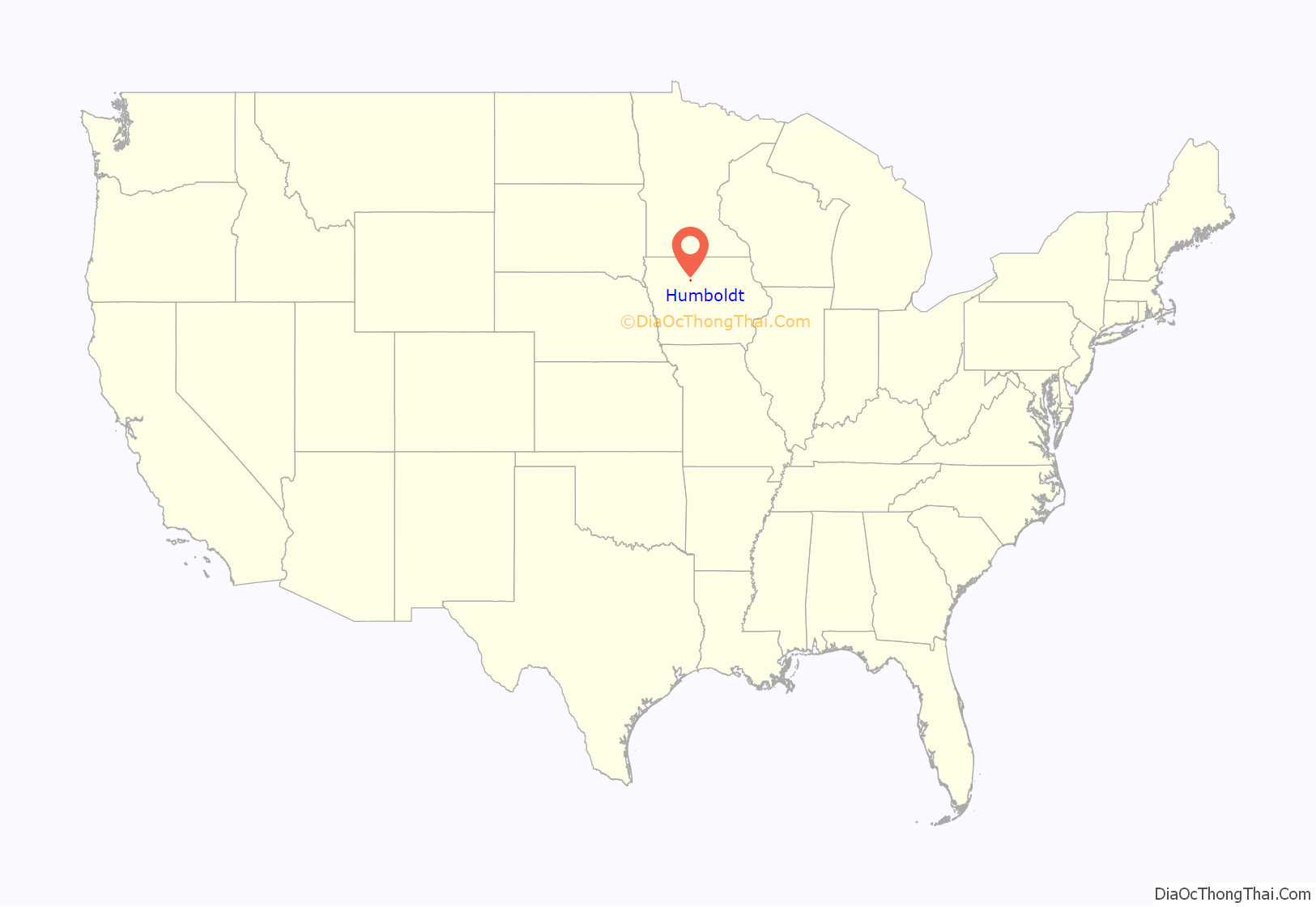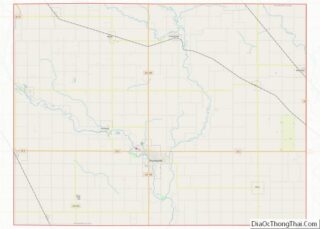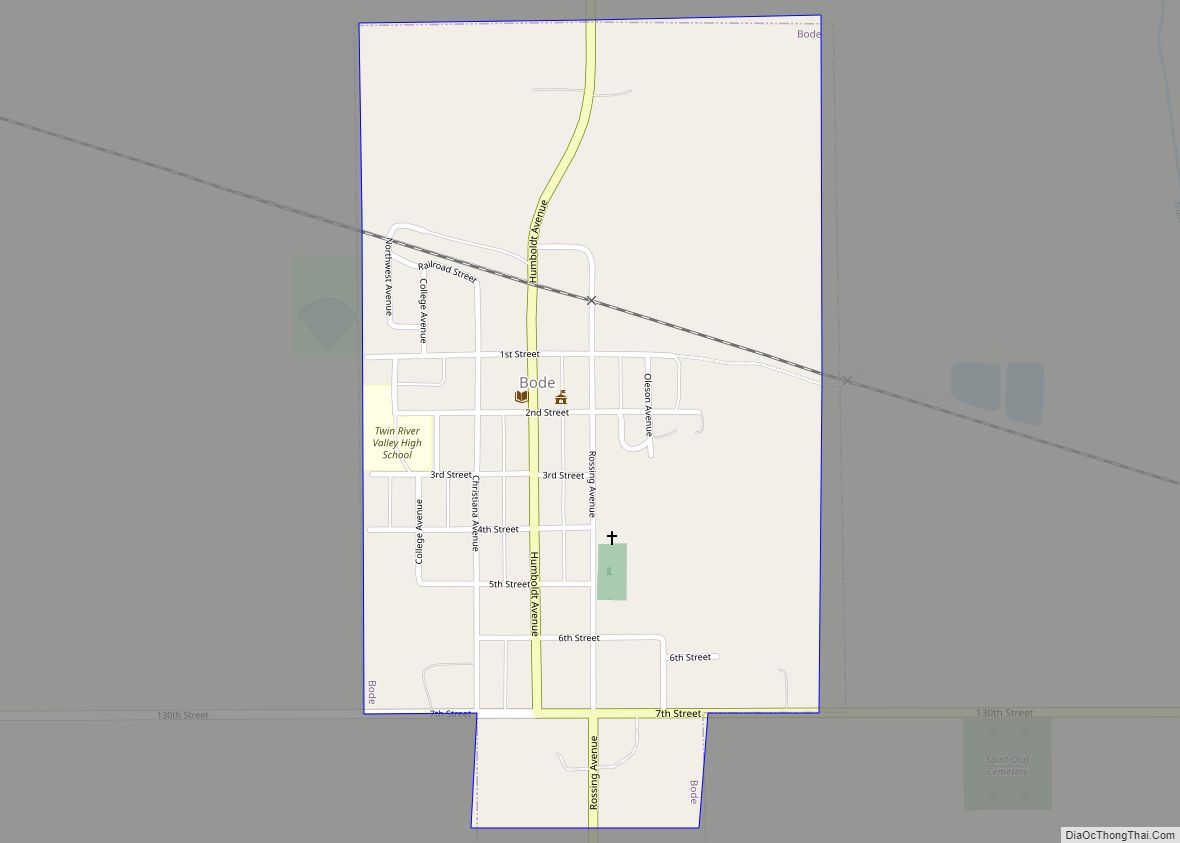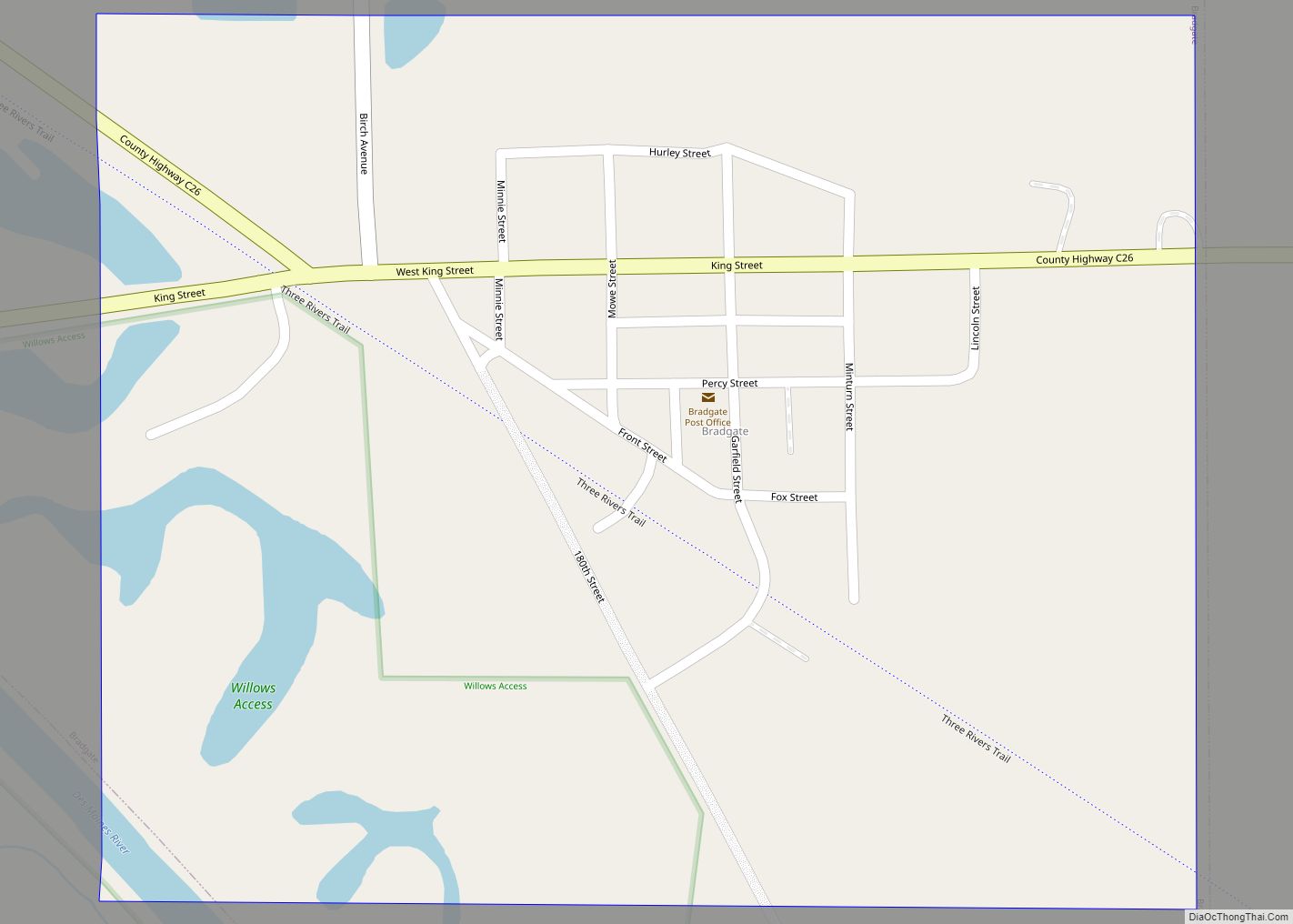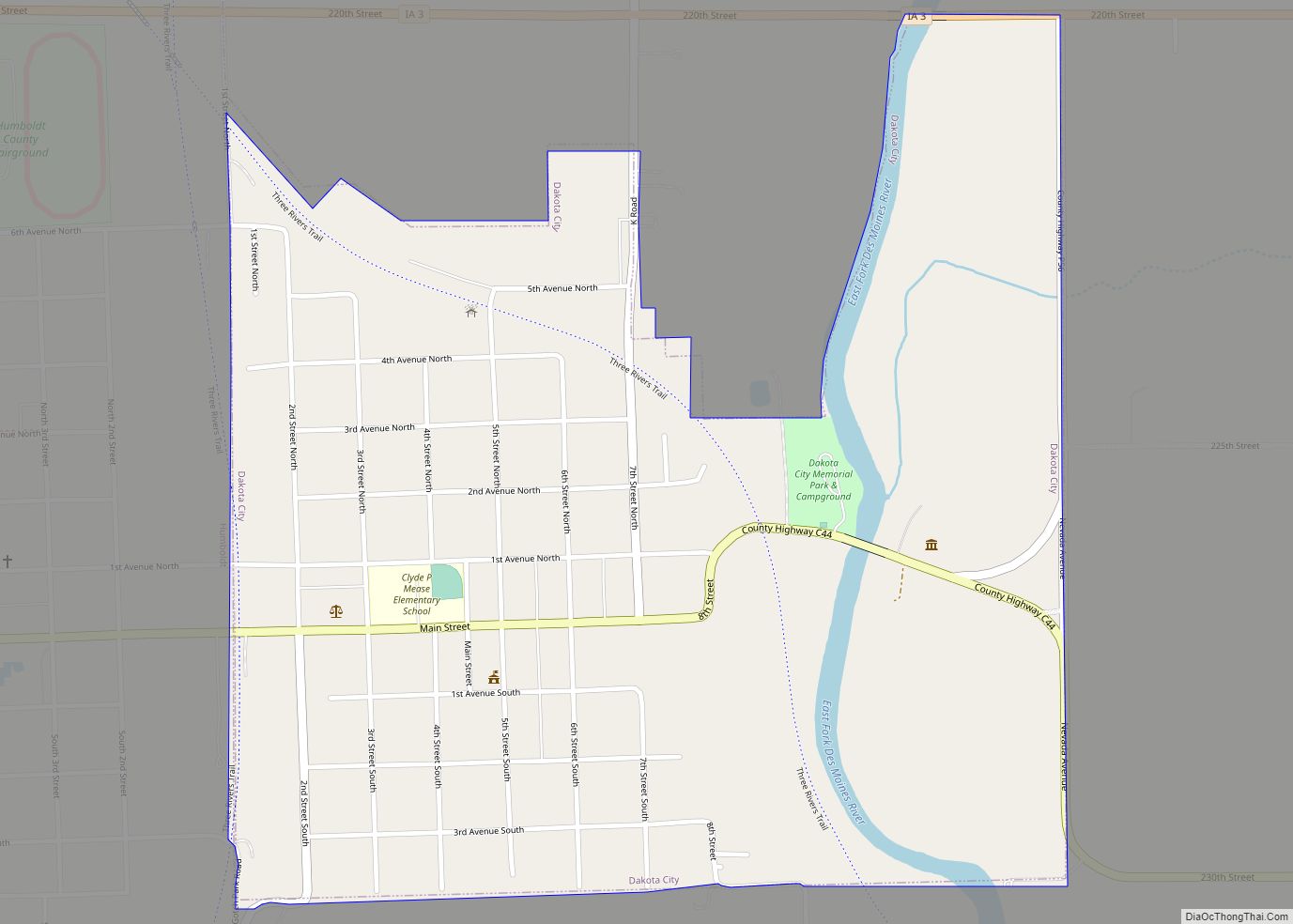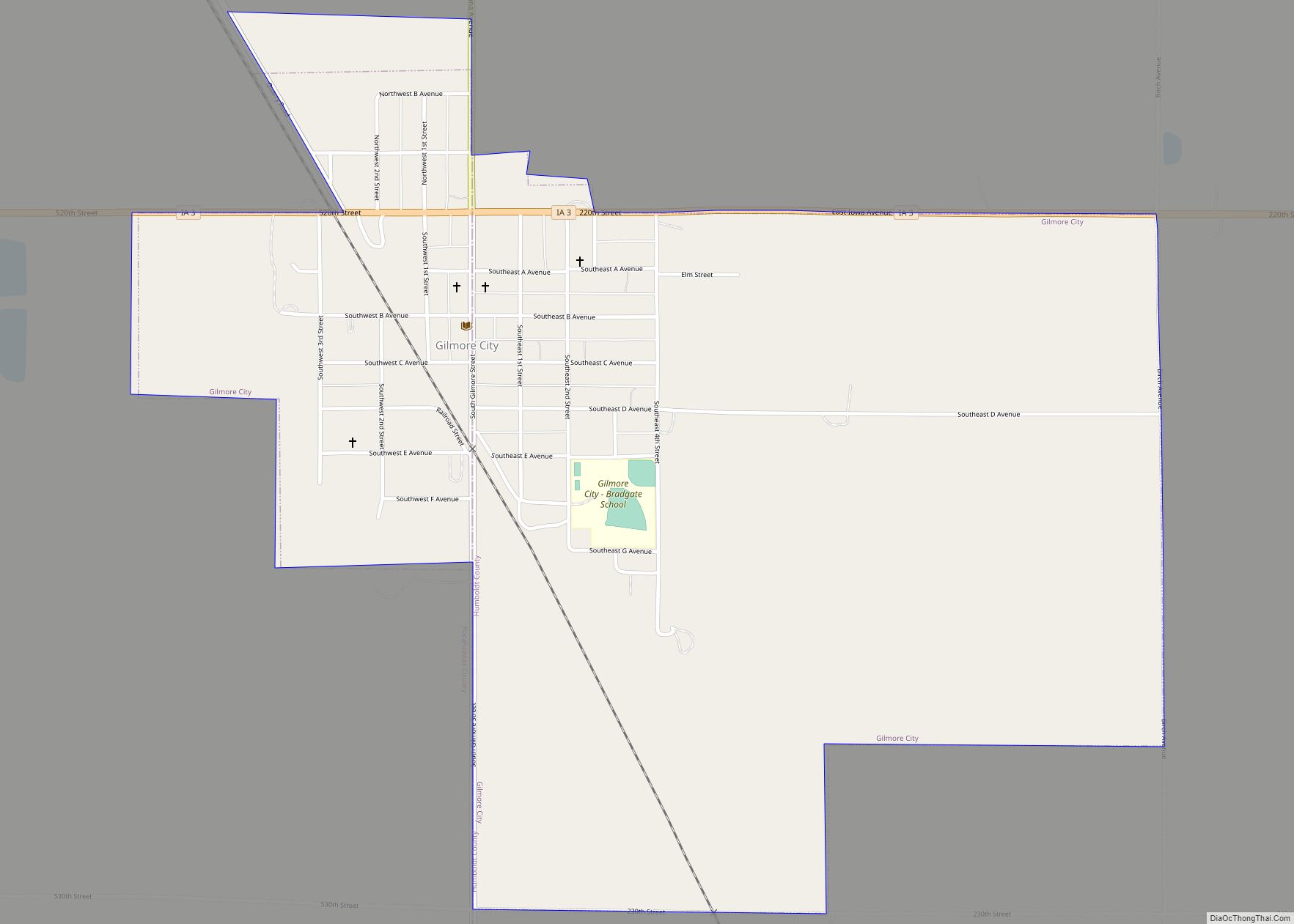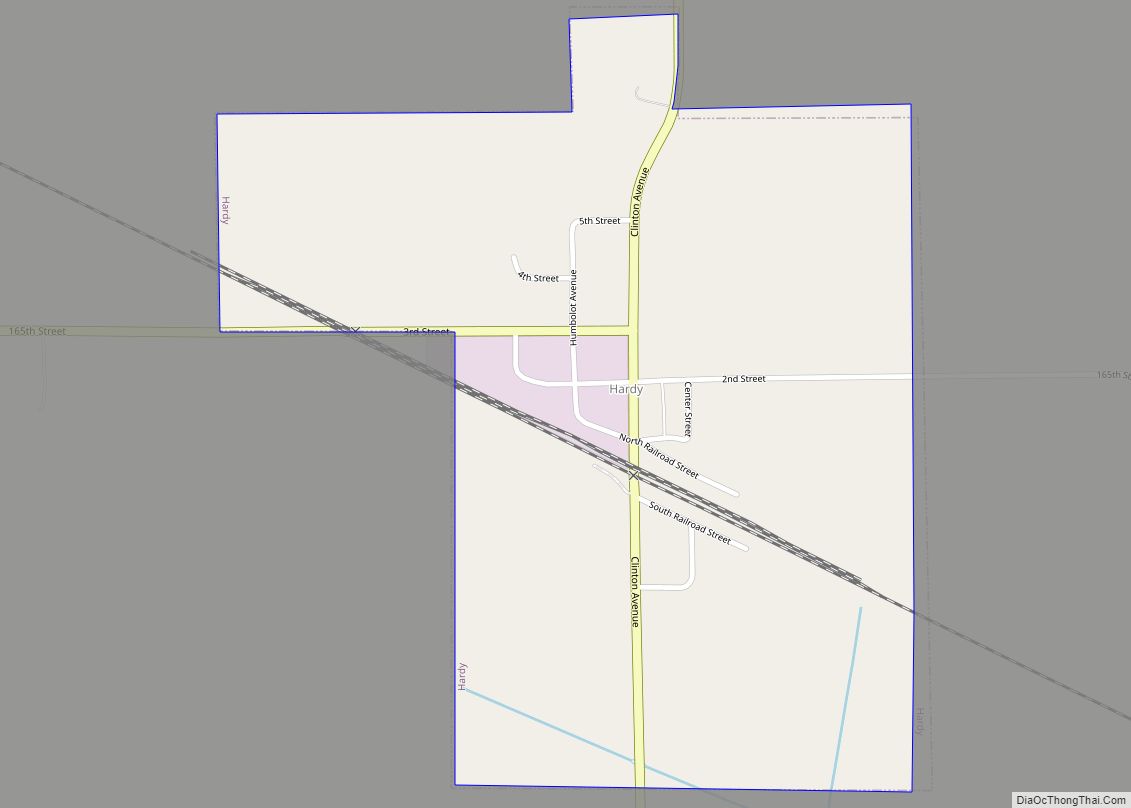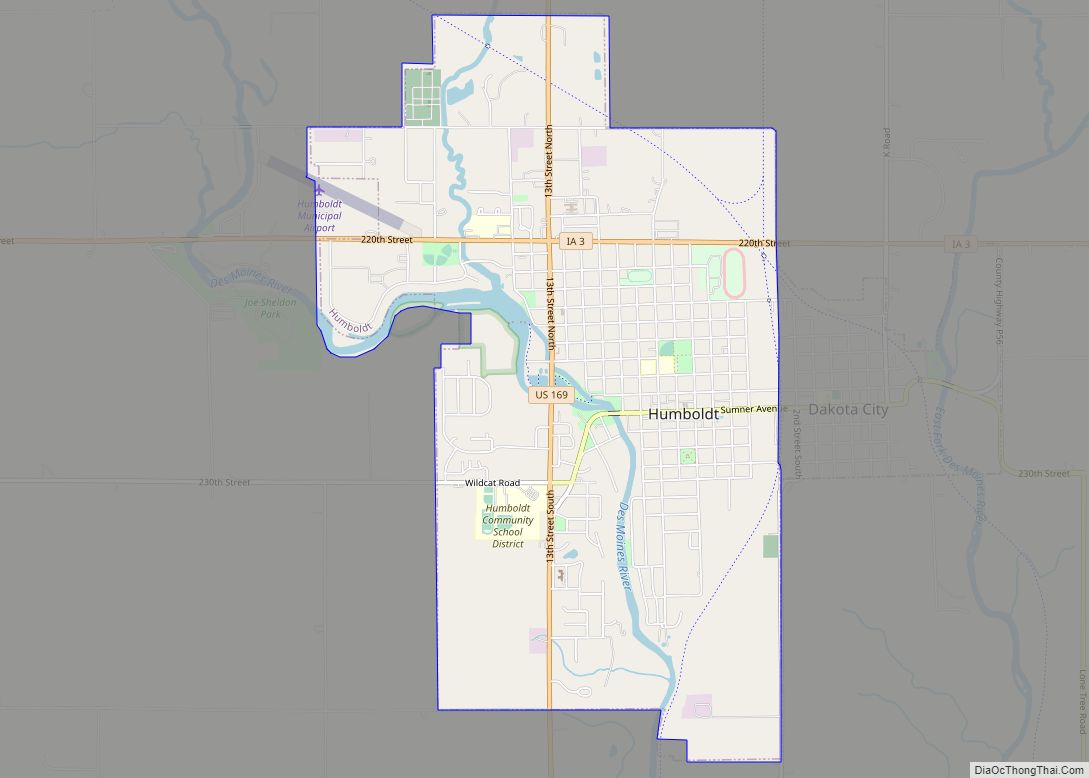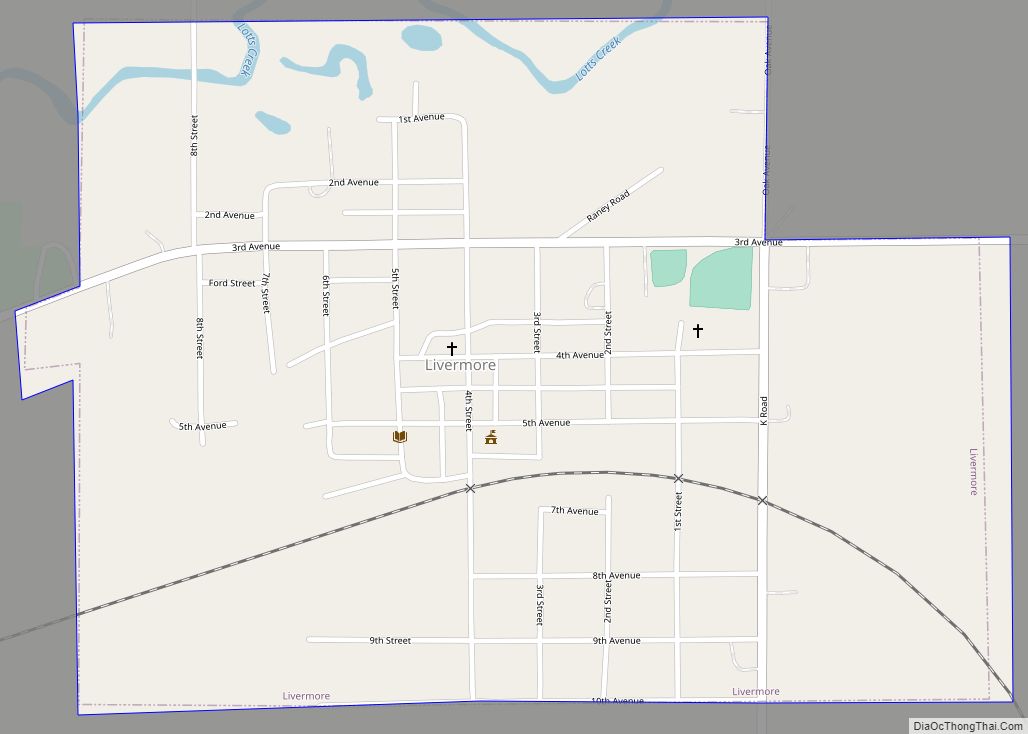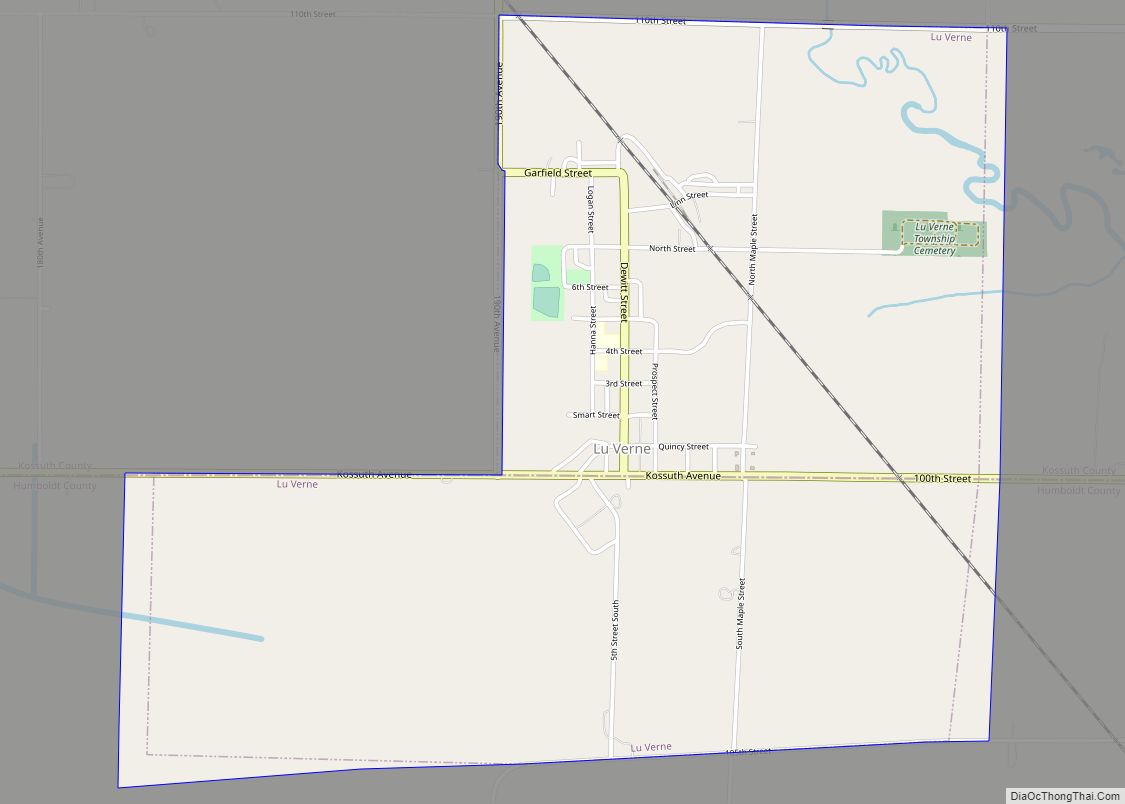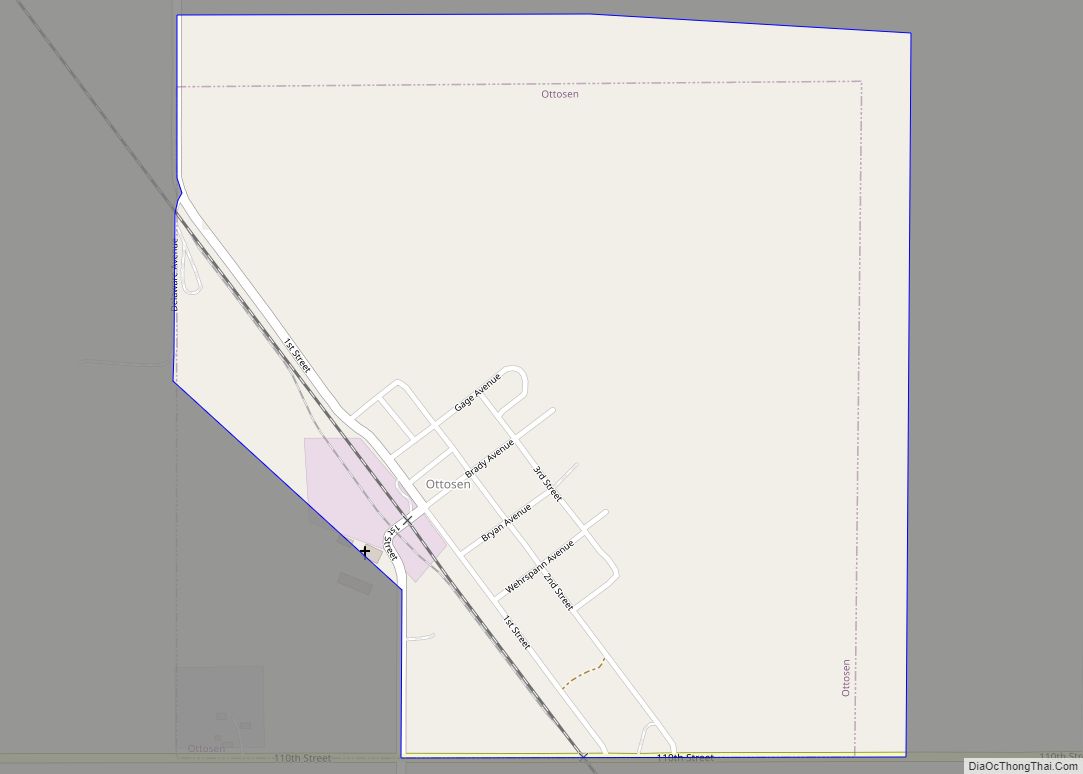Humboldt is a city in Humboldt County, Iowa, United States. The population was 4,792 at the time of the 2020 census, gaining 102 people over the 2010 total.
| Name: | Humboldt city |
|---|---|
| LSAD Code: | 25 |
| LSAD Description: | city (suffix) |
| State: | Iowa |
| County: | Humboldt County |
| Elevation: | 1,083 ft (330 m) |
| Total Area: | 4.68 sq mi (12.13 km²) |
| Land Area: | 4.53 sq mi (11.73 km²) |
| Water Area: | 0.15 sq mi (0.40 km²) |
| Total Population: | 4,792 |
| Population Density: | 1,058.07/sq mi (408.54/km²) |
| ZIP code: | 50548 |
| Area code: | 515 |
| FIPS code: | 1937560 |
| GNISfeature ID: | 0457717 |
| Website: | http://www.ci.humboldt.ia.us/ |
Online Interactive Map
Click on ![]() to view map in "full screen" mode.
to view map in "full screen" mode.
Humboldt location map. Where is Humboldt city?
History
Frank A. Gotch Park (just south of present-day Humboldt and Dakota City) was a location of prehistoric and some Dakota Indian villages near where the two forks of the Des Moines River meet. During westward expansion in the 1800s, this area is thought to be the location of a fort/trading post called Fort Confederation. According to Federal records in 1825, permission was granted to build the fort to trade with the Ihanktonwan Dakota (Yankton Sioux) Indians. Information about the exact details of the fort are unclear, such as if American or French Canadian or Metis traders built it, bringing up many questions about this fort.
The founder of modern Humboldt, Stephen Harris Taft, laid out the plans for Springvale, the original name of the town, in 1863. It was named Springvale because of the several natural springs found near the Des Moines River. Taft had very big plans for the community, and expected many intellectuals from the East to move to his new community.
Taft had five goals for his idyllic community.
- The town shall be surrounded and full of trees and forests.
- The town shall be free of the sale of intoxicants.
- The town shall be founded upon a saw mill and grist mill on the Des Moines River
- The town shall have the moral fortitude of a solid church and good schools, and that it shall become a town of thinkers and beauty.
- The town shall grow with a college of university importance, and have a church that will not dissent into factions.
Taft undertook the great task of turning empty, blooming prairie into the community of his dreams. He brought out a group of settlers (including a doctor) in 1863, and they lived together in the few houses that had been built. The grist mill was built, known now as the Corydon Brown House. The first few years were spent laying out the town. Taft wanted very wide boulevards throughout the town, and the community is still known for its streets. Taft also edited the Humboldt County True Democrat through the offices of the Fort Dodge Sentinel in Fort Dodge.
Springvale was renamed Humboldt (after the German explorer and naturalist Alexander von Humboldt) in hope of a merger between Springvale and Dakota City (the county seat of Humboldt County), but no merger took place. This is the first of two major shortcomings that would stunt Humboldt’s growth and keep it from reaching Taft’s goals.
A meeting in 1866 occurred that formed the Springvale Collegiate Association, led by Taft. After the flood in 1867 that destroyed the town’s dam, the issue became popular again in 1869. The association was renamed to Humboldt Collegiate Association in accordance with the town’s name change. It was reported that “great enthusiasm” was the feeling in the room, however when the question was posed to the county’s voters on October 12, 1869, the measure to appropriate swampland for a Northern Iowa College was defeated. Taft was not defeated, however, and looked East for funding. After almost missing a payment deadline that would’ve sunk the college for good, Taft broke ground on June 17, 1870. He ended his address by saying “Hundreds are here present today. Tens of thousands shall gather here a hundred years hence to commemorate the birth of the institution and rejoice in the blessings it shall have conferred.”
Humboldt College opened its doors on September 13, 1872. The first three years were designed as preparatory work intended to supplement the pupils’ public education that ended around eighth grade. The subsequent four years were college work. June 1879 brought the first graduation class of three families. They would be the only students to ever receive a degree from the institution. At this time, Taft and the college were in financial trouble. An endowment fund capable of supporting Taft’s vision seemed impossible to create, and following turbulent financial times in the East, the college closed in 1916. The building was razed in 1926, following unsuccessful attempts to rent the structure. Without the college, Taft’s dreams of Humboldt becoming an intellectual center of knowledge in the West could not be realized.
In July 1955, when contacts between Americans and Soviets were rare, Humboldt hosted a delegation of Soviet officials (and national and international reporters) for an overnight glimpse of rural American life.
On March 27, 1972, ABC-TV broadcast a half-hour documentary on Humboldt entitled “A Small Town in Iowa.” The program was written and produced by Andy Rooney and narrated by Harry Reasoner, a Humboldt native. The show portrayed Humboldt as a kind of paradise that struggled to keep its most talented youth from leaving for larger cities, and asked, “what is it about paradise that’s turning the bright kids off?” The answer, according to Reasoner and Rooney, was that “what seems to be missing is more a shortcoming of ours, than of the small town. It is that those of us with ego and ambition are not usually happy performing in front of an audience the size a small town provides.”
The First National Bank of Humboldt and its shareholders were the primary victims of what the Des Moines Register described as “one of the most spectacular white-collar crimes in state history.” In 1982 Humboldt native Gary Vance Lewellyn, then a Des Moines stockbroker, attempted to pump up the value of the stock of a high-tech company by singlehandedly creating phony market demand for it. To carry out the scheme, he illegally obtained access to bonds of the First National Bank of Humboldt valued at $16.7 million, and secretly pledged the Bank’s bonds as security for his personal orders of the company’s stock through Wall Street investment firms. When Lewellyn missed margin calls on his stock purchases, the firms obtained the bonds. Suspicious federal regulators closed the Humboldt Bank when it could not account for its missing bonds (and considered, but rejected, the idea of liquidating it). Its accountholders were protected by federal insurance but the shares in the bank became worthless. For his crime, Lewellyn was sentenced to twenty years in prison, but served only five years. Lewellyn died in 2012.
Humboldt Road Map
Humboldt city Satellite Map
Geography
Humboldt is located at 42°43′25″N 94°13′17″W / 42.72361°N 94.22139°W / 42.72361; -94.22139 (42.723631, -94.221520). According to the United States Census Bureau, the city has a total area of 4.80 square miles (12.43 km), of which 4.64 square miles (12.02 km) is land and 0.16 square miles (0.41 km) is water.
Humboldt County is located entirely within the Des Moines Lobe of the Western Corn Belt Plains ecoregion, as defined by the United States Environmental Protection Agency (EPA). One of the flattest regions in Iowa, the Des Moines Lobe ecoregion is a distinctive area naturally defined by Wisconsin glaciation but modified by humans for extensive agriculture. In general, the land is level to gently rolling with some areas of relief defined by glacial features like moraines, hummocky knobs, and kettles, and outwash deposits. The lobe does not have any loess deposits like the Loess Hills to the west.
The stream network is poorly developed and widely spaced, with major rivers carving valleys that are relatively deep and steep-sided. Almost all of the natural lakes of Iowa are found in the northern part of this region (the Iowa Great Lakes). Most of the region has been converted from wet prairie to agricultural use with substantial surface water drainage. Only a small fraction of the wetlands remain, and many natural lakes have been drained as a result of agricultural drainage projects via drainage tiles or ditches.
Climate
Humboldt, like almost all of Iowa, has a humid continental climate (Köppen Dfa). Humboldt experiences all four seasons characterized by cold winters, wet springs, hot summers, and relatively short autumns. Wide temperature ranges are common within this climate zone.
See also
Map of Iowa State and its subdivision:- Adair
- Adams
- Allamakee
- Appanoose
- Audubon
- Benton
- Black Hawk
- Boone
- Bremer
- Buchanan
- Buena Vista
- Butler
- Calhoun
- Carroll
- Cass
- Cedar
- Cerro Gordo
- Cherokee
- Chickasaw
- Clarke
- Clay
- Clayton
- Clinton
- Crawford
- Dallas
- Davis
- Decatur
- Delaware
- Des Moines
- Dickinson
- Dubuque
- Emmet
- Fayette
- Floyd
- Franklin
- Fremont
- Greene
- Grundy
- Guthrie
- Hamilton
- Hancock
- Hardin
- Harrison
- Henry
- Howard
- Humboldt
- Ida
- Iowa
- Jackson
- Jasper
- Jefferson
- Johnson
- Jones
- Keokuk
- Kossuth
- Lee
- Linn
- Louisa
- Lucas
- Lyon
- Madison
- Mahaska
- Marion
- Marshall
- Mills
- Mitchell
- Monona
- Monroe
- Montgomery
- Muscatine
- O'Brien
- Osceola
- Page
- Palo Alto
- Plymouth
- Pocahontas
- Polk
- Pottawattamie
- Poweshiek
- Ringgold
- Sac
- Scott
- Shelby
- Sioux
- Story
- Tama
- Taylor
- Union
- Van Buren
- Wapello
- Warren
- Washington
- Wayne
- Webster
- Winnebago
- Winneshiek
- Woodbury
- Worth
- Wright
- Alabama
- Alaska
- Arizona
- Arkansas
- California
- Colorado
- Connecticut
- Delaware
- District of Columbia
- Florida
- Georgia
- Hawaii
- Idaho
- Illinois
- Indiana
- Iowa
- Kansas
- Kentucky
- Louisiana
- Maine
- Maryland
- Massachusetts
- Michigan
- Minnesota
- Mississippi
- Missouri
- Montana
- Nebraska
- Nevada
- New Hampshire
- New Jersey
- New Mexico
- New York
- North Carolina
- North Dakota
- Ohio
- Oklahoma
- Oregon
- Pennsylvania
- Rhode Island
- South Carolina
- South Dakota
- Tennessee
- Texas
- Utah
- Vermont
- Virginia
- Washington
- West Virginia
- Wisconsin
- Wyoming
